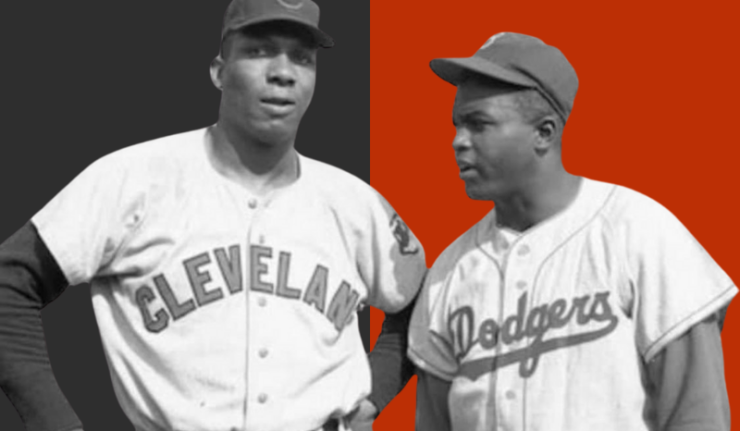Easter usually played the game with a scowl on his face, though it wasn’t because he was cross. He just concentrated a lot when he was on the diamond. Easter was physically impressive: 6’4 and close to 250 pounds. He looked like a defensive end instead of a baseball player. He was a hulking, left-handed power hitter and a bit of an enigma. Few people knew where he was from or when he was born, and ultimately when Easter met his maker in a violent manner, he still clung to his secrets.
Luscious Luke Easter was born in Mississippi, somewhere between one of the S’s and I’s, or near Jonestown, most likely. He told people he was born in the 1920s when that suited him, or in 1914 or even 1913, when that was to his advantage. We have good evidence that Luke attended the same high school in Missouri as Quincy Trouppe, a future star catcher in the negro leagues. Trouppe was born in 1913, but no one knows if he was the same age as Easter, or a few years older.
In the mid-1930s, Easter’s name began to appear on rosters of various teams in professional baseball. Originally, he was a center fielder, but his large frame wasn’t made for chasing fly balls, so he was moved to first base.
More than once, Easter tempted the grim reaper. In 1939, he was on a train that derailed in Indiana, a disaster that claimed five lives. A few years later Luke was a passenger in an automobile driven by teammate Sam Jethroe. The car went off the road and into a group of trees. Another passenger was seriously injured, but Luke escaped with a broken ankle. That fractured bone kept him out of combat in World War II, when he served in the U.S. Army as a chemical plant worker stateside.
Luke was a card player and a drinker. He liked to hang out with the boys, and he took to the nomadic lifestyle of a professional ballplayer, enjoying the cross-country train rides, hotel meals, and nightlife in strange cities. He was a skirt chaser and he often arrived at the ballpark late and more than a little hungover.
But his lifestyle didn’t stop Luke from battering the baseball. In 1948 he led the Negro National League in home runs, slugging, and OPS. He played in both of the league’s All-Star Games that season, and reportedly smacked a baseball more than 500 feet at Yankee Stadium.
Paychecks were vital to Luke Easter’s pursuit of gin and ladies, so he usually played baseball 11 months out of the year, joining Cuban or Mexican teams in the winter. One season he hit .400 in Cuba, and another he won the triple crown and MVP in Puerto Rico. After his MLB career, Easter continued to play in the minor leagues in the U.S., and in Latin America. He appeared in his final professional game at the (apparent) age of 48.
Bill Veeck signed Easter away from the Homestead Grays, and in 1949 Easter hit 25 home runs and drove in 92 runs in only 80 games for the San Diego Padres, the Indians top farm club. Luke was clearly capable of being a star in the (mostly) white major leagues. In his first three full seasons with Veeck’s Indians, Easter was the best first baseman in the American League. He averaged 29 home runs and 102 RBI. In 1952 he finished 13th in AL Most Valuable Player Award voting.
Injuries to his feet and legs made Easter basically a stationary ballplayer, and if he was really in his late 30s by 1953, he was an old man by baseball standards. The Indians released him, but Luke played ten more seasons out of the spotlight. But his booming bat kept booming: he slugged 41 homers for Buffalo at Triple-A in 1957 when he was 41 years old(?); and the lumbering right-handed power hitter averaged 33 home runs per season from age 39 to 43. In all, “Luscious Luke” hit 234 homers at the Triple-A level in his career. Had there been a DH position at that time, Easter could have been productive in the majors into his 40s. When all the leagues are slapped together (the American League, negro leagues, minors, Cuban, Mexican, and Puerto Rican leagues), Easter likely hit close to 450 home runs.
When he no longer had the train trips and ballparks for comfort, and the camaraderie of teammates was gone, Easter spiraled into his alcoholism. He bounced from job to job, and settled in Cleveland, where he and his wife maintained a rocky relationship. Herarely talked about his baseball career, and refused to talk about his early days in Mississippi or his family. He was more interested in staring at the bottom of a bottle than talking.
In 1979, Easter was employed as a payroll guard when he was accosted by gunmen in a parking lot in downtown Cleveland. When he refused to give up the thousands of dollars he had in his possession, Easter was shot several times in the chest. He died on arrival at the hospital.
Did anyone remember Luke Easter? Thankfully, yes. More than 5,000 people viewed Easter’s casket at a public viewing in Cleveland. Fans paid their respects to one of the greatest power hitters to ever wear the Indians uniform. Former teammates Bob Lemon and Al Rosen served as pallbearers. No one knew how old he was, or even exactly where Luke Easter had been born, but on the day of his funeral, he was treated like a hero in his adopted city.
“Luke was a great-big, easy-going, devil-may-care, jolly, hail fellow, well-met kind of guy who took a ribbing and dished it out,” Rosen said.




